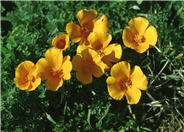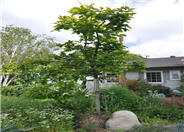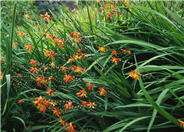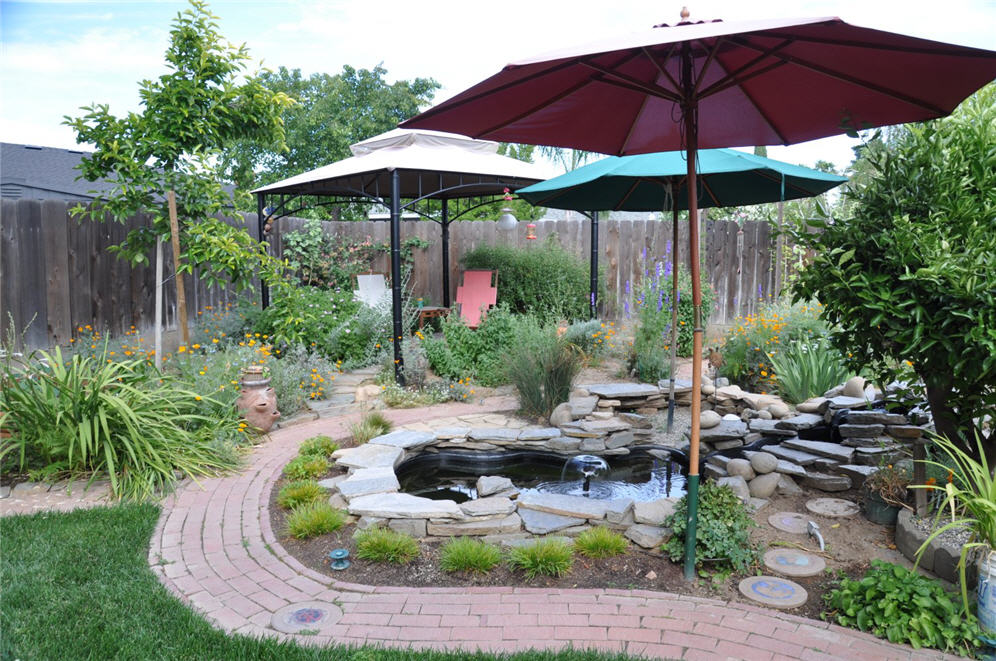
Common name:California or Golden Poppy
Botanical name:Eschscholzia californica
This small annual (sometimes acts as a perennial) plant will grow to less than 1' tall and has light, small blue-green leaves with gold and orange flowers that bloom in spring and summer.

Common name:Common Field or Slender Sedge
Botanical name:Carex praegracilis
This California native grass can tolerate occasional flooding or standing water as it is found in marshes and wetlands. It does make a great lawn substitute as it can be mowed, will take sun and part sun and need watering once a week in hot summer months. This sedge uses much less water than sod. It can be used for erosion control also.

Common name:Heartleaf Bergenia, Winter Bergenia
Botanical name:Bergenia cordifolia
This evergreen perennial has round, heart-shaped, glossy leaves that possess waxy-toothed edges. Its growth is clustered, and flowers that bloom in the spring are in shades of lilac or rose, held on stems above the leaves.

Common name:Japanese or Oriental Persimmon
Botanical name:Diospyros kaki
This medium-sized tree will grow 15'-30' tall and has bright green summer leaves, orange red fall foliage, with white spring blooms, and orange fruit that persists on deciduous winter branches. It will do best in full sun, slightly acidic well draining soil. It does best with medium amount of watering as you will get more fruit.

Common name:Endress' Cranesbill
Botanical name:Geranium endressii
This handsome perennial, used a ground cover, has evergreen dark green, veined and glossy leaves, Small pink, cup shaped flowers bloom in spring and summer. This plant reaches 1'-1.5' tall and spreads 2'-4' wide. Shear plant when first blooms fade, in order to encourage more blooms. It prefers full to part sun, with well draining soil.

Common name:Montebretia
Botanical name:Crocosmia X crocosmiiflora
Montebretia is a bulb, closely resembling gladiolus. Vertical, strap like leaves grow to 3' tall. Brilliant red, coral/apricot, red, red-orange, or bright yellow flowers sit on top of arching stalks during the summer. Plants may wither in winter but come back in spring. It requires sun to part shade. Once this plant is established, it requires little or no summer watering. This plant performs well in containers as it is considered invasive in some areas.

Common name:Endress' Cranesbill
Botanical name:Geranium endressii
This handsome perennial, used a ground cover, has evergreen dark green, veined and glossy leaves, Small pink, cup shaped flowers bloom in spring and summer. This plant reaches 1'-1.5' tall and spreads 2'-4' wide. Shear plant when first blooms fade, in order to encourage more blooms. It prefers full to part sun, with well draining soil.

Common name:Snow-In-Summer
Botanical name:Cerastium tomentosum
Masses of snow white flowers highlight this plant during the early summer season. This attractive ground cover is a great filler among other plants and rocks. Foliage is silver gray or gray/green and is woolly. This plant tolerates coastal conditions and desert areas. Use in rock settings, in hanging baskets, containers, or as a lawn substitute. Cut back in fall to refresh plant.

Common name:Bearded Iris
Botanical name:Iris Bearded Hybrids
This perennial will grow 1'-3' tall and has medium sized, blue green leaves with flowers of different colors that bloom in spring. It needs well draining soil and full sun. Many are fragrant and rebloom in the fall. Plant rhizomes in Sept or Oct. They need water once a week during the hot spells. Top dress with compost and gypsum in January and August.
| Designer: Terri Nichols | Circulating Water Pond |
Photographer: GardenSoft |
Soils and Compost:
Maintain a two to four inch layer of mulch on the soil surface to reduce weeds, infiltrate rain water, and reduce compaction.
Water Saving Tip:
Group plants in your garden according to their water needs (hydrozone).
Integrated Pest Management:
Attract, or buy beneficial insects such as ladybugs and lacewings to control pest outbreaks in your garden.
